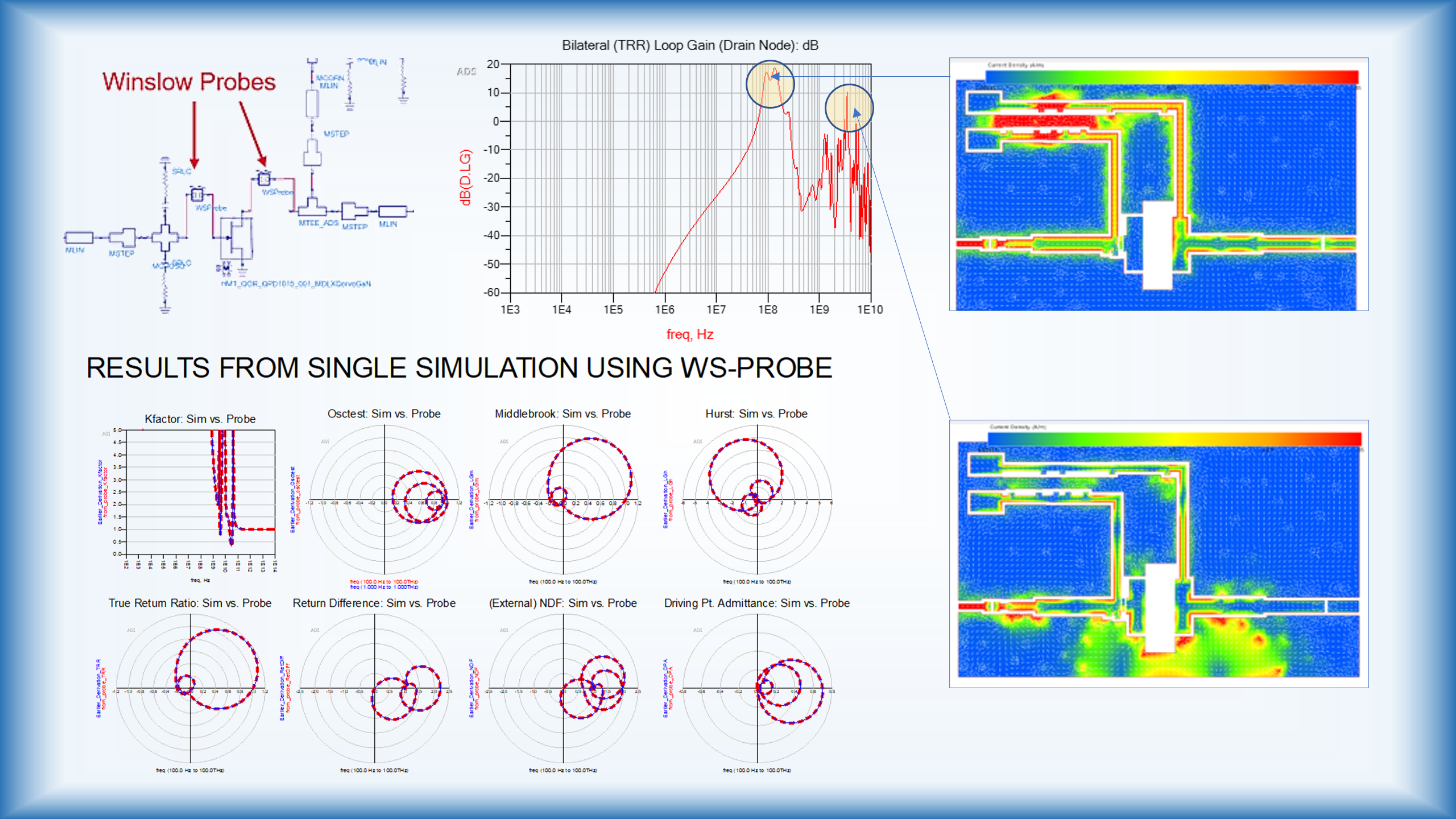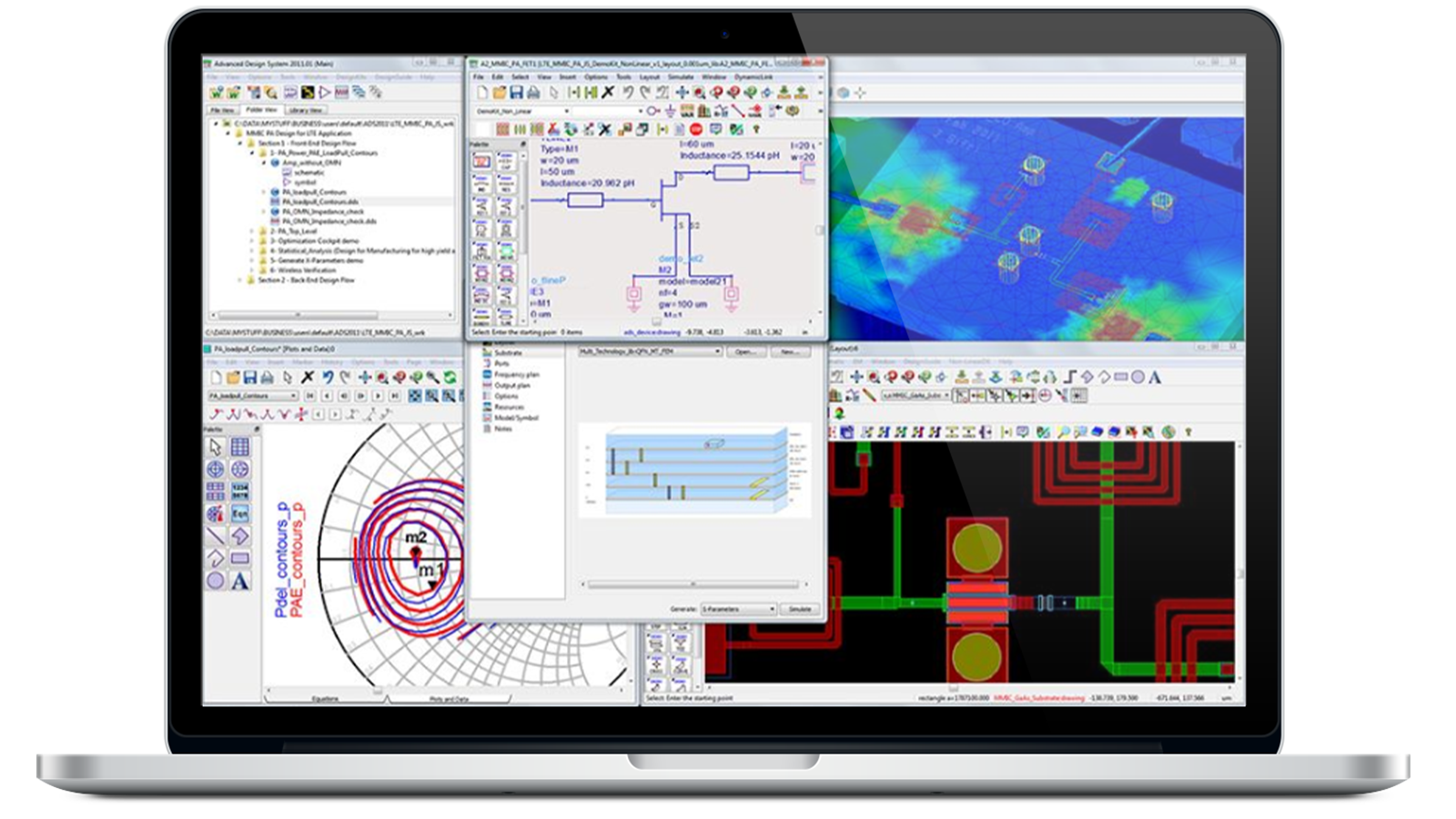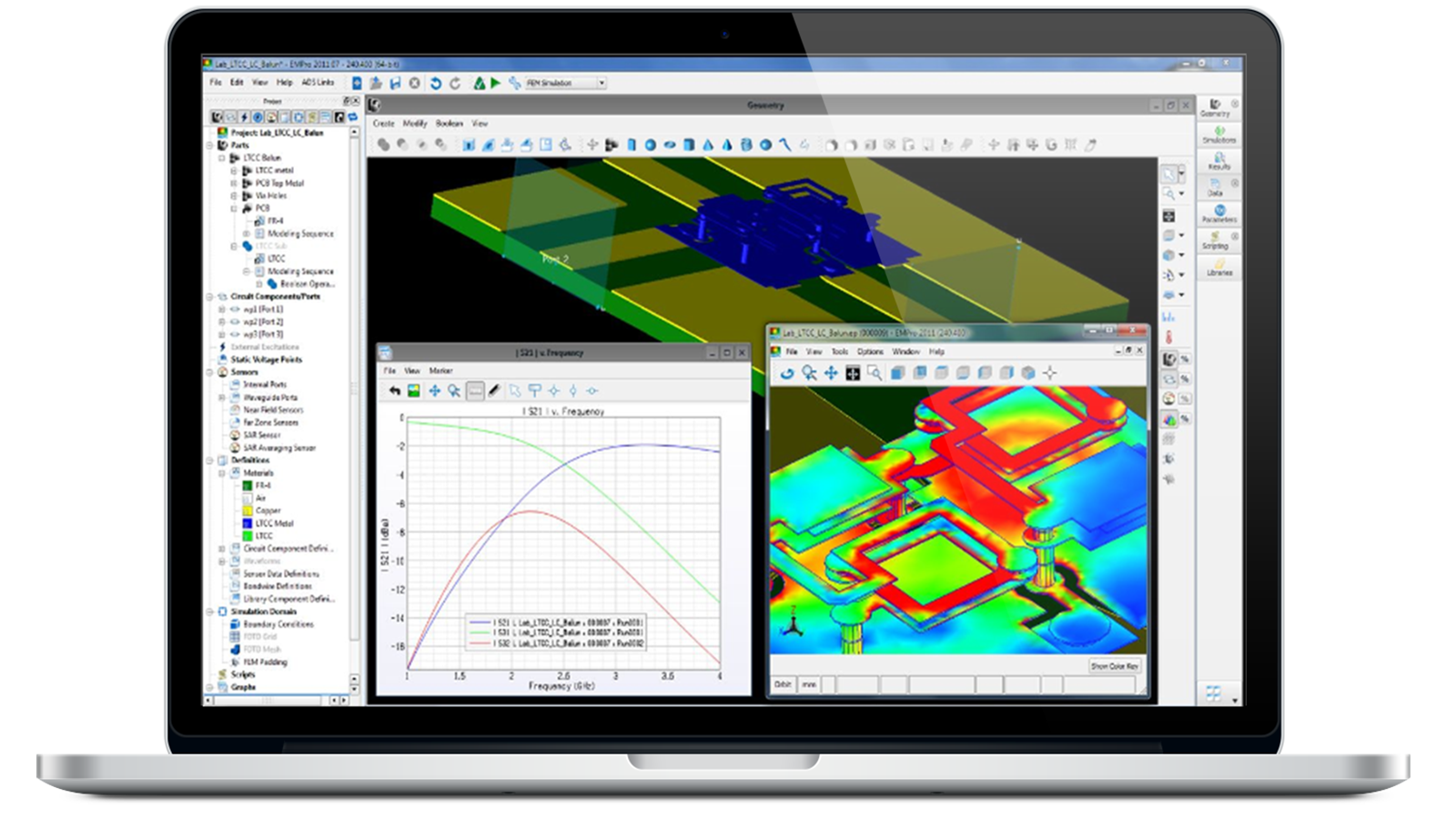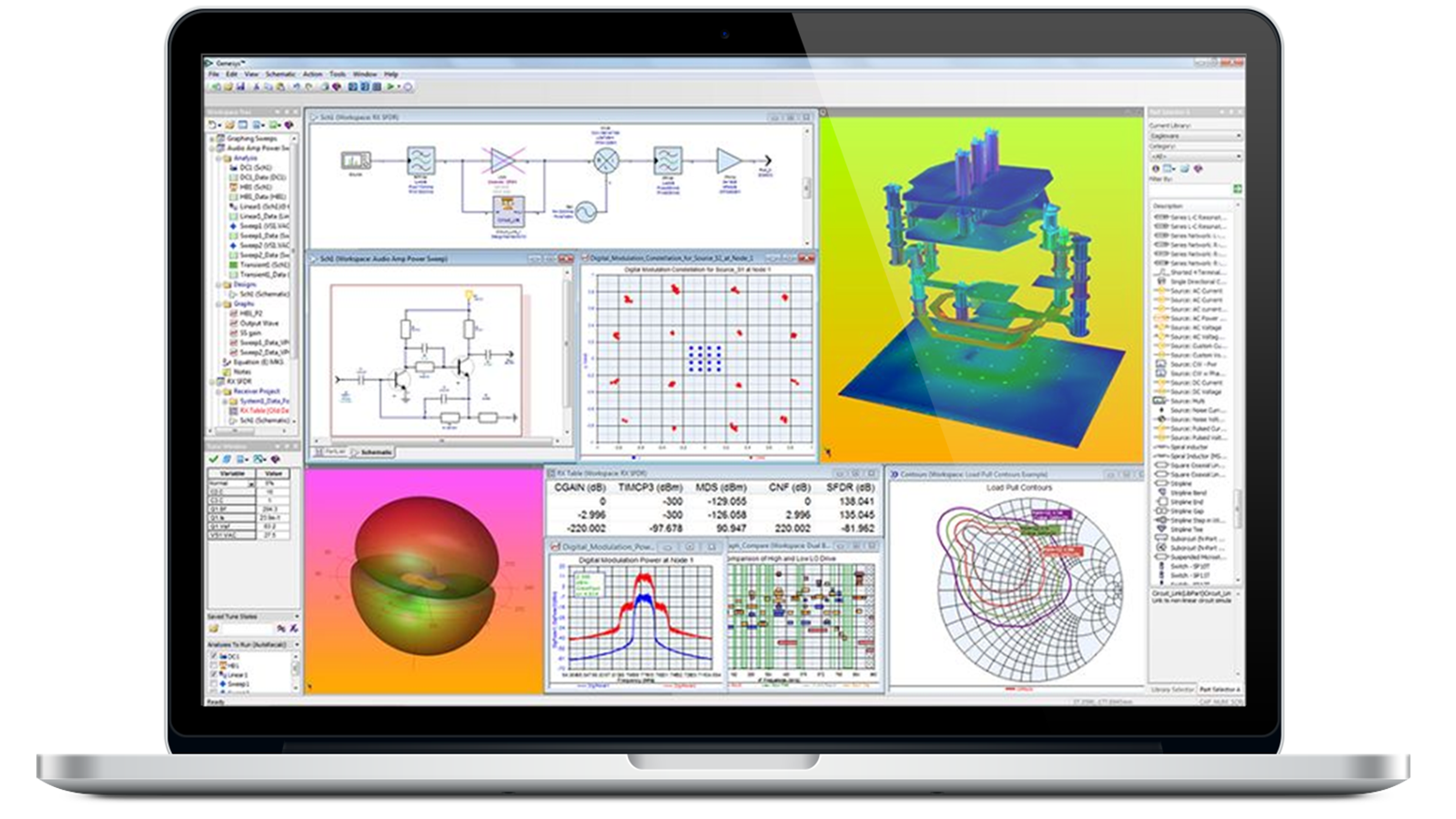What are you looking for?
RF and Microwave Circuit Design Software
Achieve consistent RF design wins
As radio-frequency (RF) applications move into millimeter-wave (mmWave) frequencies, integration is becoming denser. This density increases the complexity of correctly assembling, simulating, and verifying multi-technology RF modules. Keysight PathWave Advanced Design System (ADS) helps reduce costly hardware failures by enabling intelligent integration of modules that interconnect circuit design softwares, including radio-frequency integrated circuits (RFIC), monolithic microwave integrated circuits (MMIC), laminate, wafer-level packaging, antennas, and printed circuit boards (PCBs) into dense 3D structures.

Designing With Digitally Modulated Signals
RF circuits process digitally-modulated signals. They require error vector magnitude (EVM) as a figure of merit instead of the traditional P1dB or IP3 analog specifications. With PathWave ADS, you can simulate EVM at the circuit level for tuning and optimization. Then you can verify to industry wireless standards such as 5G, automotive radar, and WiGig by leveraging the signal-generation and processing algorithms leveraged from Keysight RF instrumentation.
View Webinar
Designing with 5G Modulated Signals
Digital Pre-Distortion in PAs
Designing for Modulation with Keysight EDA
Read MWJ Article
Solving Electromagnetic Densification
Learn about Amplifier Digital Pre-Distortion (DPD)
PathWave DPD Explorer in PathWave ADS
Amplifier Stability Analysis
Tight integration in RF modules gives rise to unintended electromagnetic (EM) coupling and feedback loops in amplifiers that can cause instability, resulting in costly hardware failures.
PathWave ADS provides a rigorous and comprehensive amplifier-stability analysis capability. It replaces 14 traditional techniques to guarantee amplifier stability under all linear and nonlinear conditions. Combining stability analysis with EM-circuit co-simulation helps you locate and fix causes of instability before building hardware to achieve early design wins.
View Webinar
How to Design a Stable High Frequency Amplifier
Read Application Note
Designing for Stability in High Frequency Circuits


Multi-Technology RF Module Assembly for Em-Circuit Co-Simulation
PathWave ADS enables error-free assembly and 3D avoidance routing to interconnect RFICs, MMICs, laminates, wafer-level packaging, antennas, and PCBs into multi-technology RF modules.
RFPro then runs EM-circuit co-simulation on any portion of the RF module without modifying the 3D layout for tuning and optimization so you can perfect your design before building hardware. RFPro lets you use EM analysis as an interactive RF circuit design tool instead of a one-time verification tool to get to market faster.
Design RFIC and MMIC with Foundry Process Design Kits (PDK)
ADS is endorsed by leading Silicon and III-V foundries to enable the design of high performance RFICs and MMICs that must work when integrated in multi-technology RF modules which combine fan-out wafer level packaging (FOWLP), 3D interconnects, laminates and antennas.
Now RFICs and MMICs need not be designed in isolation, but proven within the final application such as 5G, automotive radars, or wireless networking, so that you can consistently achieve design wins with your customers.
Learn More

High Performance Computing (HPC) for EM and Circuit Simulation
Reduce simulation time by 80% for large designs that take hours to simulate. Use your own compute cluster or cloud compute service to run parallel jobs through an easy-to-use Design Cloud interface in ADS. Once launched, you can disconnect your local machine for other tasks and later reconnect to download finished results. HPC 1-pack makes it affordable to scale up parallelism as needed to thoroughly and quickly simulate/verify every aspect of your design before hardware production to avoid costly failures.
More Circuit Design Software
Find the Model that's Right for You
Software Enterprise Agreement
Deploy a Keysight Software Enterprise Agreement to capture continuous value for your organization. Enterprise Agreements deliver flexible, cost-effective access to Keysight’s broad software portfolio through a re-mixable license pool.
Protect Your Innovation Investment
Featured Resources
Frequently Asked Questions
RF circuit design involves designing and simulating electronic circuits that operate in radio frequencies (RF) and millimeter-wave frequencies, typically ranging from a few kHz to several hundred GHz. Various applications use these circuits such as wireless communication, radar systems, satellite communication, automotive, and more.
Circuit simulation is a computational technique used to model and analyze the behavior of electronic circuits. The first step is creating a mathematical circuit model representing the circuit's components and interconnections. Mathematical equations or models describe each component capturing its behavior under different operating conditions. After modeling the circuit, engineers use simulation software to solve the equations and analyze the circuit's behavior. Today’s increasingly complex, dense RF circuit designs require complex simulators capable of handling large and intricate circuits.
The critical components of an RF circuit include amplifiers, oscillators, filters, mixers, modulators / demodulators, antennas, transmission lines, and matching networks.
The Smith chart represents complex impedance and reflection coefficient values in a two-dimensional chart. It's typically plotted on a polar coordinate system, with the horizontal axis representing resistance (real part) and the vertical axis representing reactance (imaginary part). The Smith chart is a powerful tool for RF design engineers, providing a graphical representation that simplifies the analysis and design of transmission lines, impedance-matching networks, and other RF circuits.
Some common challenges in RF circuit design include impedance matching, noise, linearity, stability, bandwidth, power consumption, and interference. As design densification increases, advanced design challenges could include integrating different materials, 3D integration, and advanced packaging techniques.
Using higher frequency transistors complicates the design flow for designing stable circuits. In today’s circuits, the gain is higher due to increasing transistor operating frequency limits (fTs), or the frequency at which unity current gain goes to zero. Tight integration and feedback because of the RF coupling can cause instability problems at lower frequencies due to significant increases in gain. The Keysight Winslow stability probe (WS-probe) is an in-circuit probe that replaces the traditional setups for multi-device amplifiers to derive the necessary stability measures quickly and efficiently.
Measuring error vector magnitude (EVM) can have its challenges — the first task is determining measurement speed. Distortion EVM estimates the error vector magnitude of nonlinear simulations without needing an external system simulator. Distortion EVM can help designers quickly assess the EVM during the design phase and speed up simulation time by a factor of ten. The second task requires accurately generating a representative 5G test waveform approximating the signal characteristics. If you can find an accurate representative waveform, you must demodulate or demultiplex the signals to arrive at the error vector magnitude. Using these test signals together with distortion EVM measurements shortens the test time for quick verification in circuit design.
Electromagnetic circuit co-simulation eliminates the delay and potential errors introduced by a separate electromagnetic (EM) solver by running a 3D finite element model (FEM) simulation automatically in the same environment with easy automated setup and analysis. This process frees the RF circuit designer to perform 3D electromagnetic analysis and EM/circuit co-simulation iteratively in the design phase. Electromagnetic / circuit co-simulation yields an order of magnitude faster setup, giving you time to schedule other simulation tasks.
AI / machine learning (ML) can increase productivity and organizational efficiency by tailoring your electronic design automation (EDA) solutions into efficient workflows and interconnected design processes. Automation and application programming interface based workflows are a cornerstone of digital transformation. With Python application programming interfaces (APIs) for Keysight EDA tools, you can control data, simulators, platforms, and processes to engineer more predictable outcomes.
The continuous rise in substrate layer counts, smaller form factors, complex packaging technologies, and closer design proximities are factors that contribute to the increasing complexity of designs. Keysight ADS is the industry-proven multi-technology 3D layout and integrated EM-circuit co-simulation platform for designing RF modules that contain radio frequency integrated circuits (RFICs) , packaging, antennas, and RF printed circuit boards (PCBs).
Want help or have questions?
























